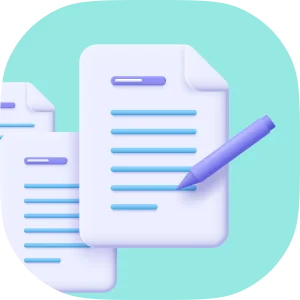🛠 Conclusion Paragraph Generator: How to Use It?
Writing an essay conclusion sounds simple until you actually sit down and open the text editor. The introduction and main body are ready, so all the necessary information is at hand. Still, deciding which facts should be mentioned in the closing part is tricky. And it is even harder to produce a brand-new paragraph about the ideas that have already been discussed above.
If you don’t know how to start off this assignment, get a sample of a tailor-made conclusion in our free tool. For this purpose, follow these 3 steps:
-
Copy your essay into the blank field on the left.
-
Specify the desired length of your conclusion.
-
Press the “Generate” button and read the result on the right.
🏁 What Is a Closing Paragraph & Why Is It Important?
A closing paragraph is the last part of any academic text. In most cases, it summarizes the central point of the paper. But depending on the assignment, it may also perform other functions. For example, a conclusion can provide a take-home message, outline the perspectives for future investigation, give advice, etc.
These functions define the importance of a conclusion. This paragraph gives the reader a feeling of completion and reminds them of what they have learned above. Sometimes it challenges them to think deeper or carry out their own research.
According to the writer’s intentions, most closing paragraphs fall under one of the following 3 categories.
🔢 Concluding Paragraph Outline
-
The topic sentence reiterates your thesis statement from an updated point of view. You have analyzed the evidence and explored the hypotheses. In your topic sentence, you can take a fresh look at your initial purposes. Don’t forget to use different words.
-
Supporting sentences list the central arguments you introduced throughout the main body. Explain why they are essential to answer the research question and how they interconnect.
-
The closing sentence may serve as a link to the introductory paragraph. It will be particularly memorable if you mention the joke or quote that started your paper.
👀 Closing Paragraph Examples: Bad & Better
The bad example above has multiple drawbacks that are corrected in the better version:
-
“In view of everything mentioned above” is too wordy. Try “in conclusion” instead.
-
“I believe” does not fit in the context. Your conclusion is based on evidence, not on your beliefs.
-
“Besides” is a conversational word. In academic texts, you could use the word “additionally.”
-
A closing paragraph should not contain in-text citations or new ideas. It only repeats what has been mentioned above.
-
The paraphrased thesis statement is the last sentence in this paragraph, which is wrong. It should go in the beginning.
-
“On any level” and “at any level” are used twice within one paragraph. It is better to look for a synonym. The same applies to the word “essential.”
-
The word “one” is used twice within one sentence, which is stylistically incorrect.
😺 Bonus: Conclusion Paragraph Starters
Find below 3 lists of closing paragraph starters for various academic paper genres.
Closing Paragraph Starters for Academic Essays
-
Having all the things considered;
-
In light of everything mentioned above;
-
In my opinion;
-
In general;
-
Nevertheless;
-
I feel we have no other option but to conclude;
-
Now that you are aware of;
-
When faced with the question of;
-
With all this in mind.
Closing Paragraph Starters for Informal Essays and Speeches
-
In simple terms;
-
Simply put;
-
Beyond any doubt;
-
My personal take on is;
-
It is high time to;
-
When all is said and done;
-
On the whole;
-
What I think is;
-
Who knew that;
-
To wrap this up.
Closing Paragraph Starters for Research Papers
-
As we expected, the results indicate;
-
Surprisingly, the data confirm that;
-
What we know now is;
-
Upon a detailed review of these findings;
-
With results like this, it may be assumed;
-
To extrapolate from the data;
-
The results of this study indicate;
-
The findings reveal.
Thank you for reading this article! If you need to quickly make a conclusion for your paper, try our closing paragraph generator.
❓ Closing Paragraph Generator FAQ
❓ What Is a Closing Paragraph?
A closing paragraph is an obligatory part of any essay or chapter in a research paper. It contains a reformulated thesis statement and several other sentences which depend on the writing genre and the author’s intentions. For example, they could summarize the core ideas, suggest the possible directions of further research, or encourage the reader to act in a certain way.
❓ How to Write a Closing Paragraph in an Essay?
- Paraphrase the thesis statement. Then, list the paragraph starters from the main body. These topical sentences transmit the main points of your text. Finish with an encouraging take-home message.
- Use this closing paragraph generator. Its embedded AI will analyze your writing and produce an appropriate conclusion in no time.
❓ How Long Should a Closing Paragraph Be?
The closing paragraph's length should correspond to your paper's length. The longer the entire text, the more word count the conclusion will have. The ending of a standard five-paragraph essay should have three or four sentences. Longer passages are allowed in research papers (more than ten pages) and can take up to several paragraphs.
❓ What Should a Closing Paragraph Consist of?
A closing paragraph consists of:
- A restated thesis statement (in consideration of everything discussed above);
- The list of primary ideas or arguments (you can find them in the main body);
- A concluding sentence (hopes for the future, author’s feelings about the issue, or advice to the reader).
Updated:

